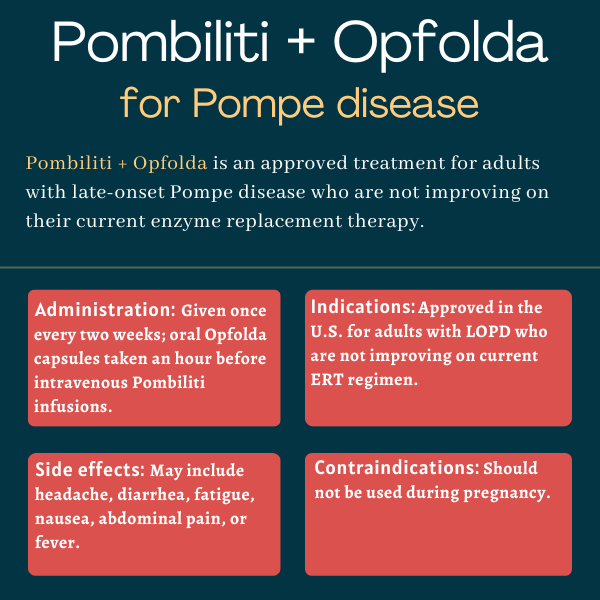Pombiliti + Opfolda (cipaglucosidase alfa/miglustat) for late-onset Pompe disease
What is Pombiliti + Opfolda for late-onset Pompe disease?
Pombiliti + Opfolda (cipaglucosidase alfa/miglustat), formerly known as AT-GAA, is an approved combination therapy for adults with late-onset Pompe disease, or LOPD. The treatment works mainly to enhance walking ability and improve or stabilize respiratory function.
It was developed by Amicus Therapeutics.
Therapy snapshot
| Brand name: | Pombiliti + Opfolda |
| Chemical name: | cipaglucosidase alfa/miglustat |
| Usage: | Treatment for certain adults with LOPD |
| Administration: | Two-part therapy administered via intravenous infusion (cipaglucosidase alfa) and oral capsules (miglustat) |
How does Pombiliti + Opfolda work?
In Pompe disease, the body is unable to make sufficient amounts of an enzyme called acid alpha-glucosidase (GAA), which is needed to break down glycogen, a complex sugar molecule. Consequently, glycogen builds up to toxic levels and damages cells, especially muscle cells that normally rely on glycogen to power their activities.
Pombiliti + Opfolda is a two-component therapy that consists of cipaglucosidase alfa, which is a man-made form of the GAA enzyme designed to effectively enter muscle cells, as well as miglustat, a pharmacological compound that stabilizes the active enzyme so it maintains its activity over time. By replacing the missing enzyme, the combination therapy is expected to ease LOPD symptoms.
Who can use Pombiliti + Opfolda?
The U.S. Food and Drug Administration approved both of the therapy’s components in 2023 for adults with LOPD who weigh at least 40 kg (about 88 pounds) and who are not improving on their current enzyme replacement therapy (ERT).
In the European Union, both components were approved in 2023 to treat adults with LOPD. First, the European Commission approved Pombiliti in March, followed by Opfolda in June.
The treatment was also approved in the U.K. for adults with LOPD in 2023. It had been available in the country through an early access program.
Who should not use Pombiliti + Opfolda?
Pombiliti + Opfolda should not be used by pregnant women, as the therapy could cause harm to a fetus. Women able to conceive must take a negative pregnancy test before starting treatment.
Pombiliti’s prescribing information has a boxed warning about the risk of life-threatening allergic reactions. If a severe reaction occurs, either due to hypersensitivity to the therapy or an infusion-associated reaction, the treatment should be discontinued immediately and appropriate medical treatment started.
People susceptible to fluid volume overload, or with acute respiratory disease or compromised cardiac or respiratory function, may be at risk of serious worsening of their cardiac or respiratory status during treatment with Pombiliti. Vitals should be carefully monitored in these patients.
How is Pombiliti + Opfolda administered?
Pombiliti is administered via into-the-vein (intravenous) infusions at a recommended dose of 20 mg/kg of body weight once every two weeks. Infusions take about four hours. The medication comes in single-dose vials that need to be reconstituted in sterile water prior to the infusion.
Opfolda oral capsules (65 mg) should be taken an hour, and no more than three hours, before each Pombiliti infusion. Patients who weigh 40-49 kg (about 88-108 lbs) should take three capsules (195 mg total) and patients who weigh 50 kg (110 lbs) or more should take four capsules (260 mg).
Capsules should be swallowed whole and taken with an unsweetened beverage. Other beverages or food should not be consumed for at least two hours before and after taking Opfolda.
Opfolda and Pombiliti are intended as a combination treatment. If Pombiliti cannot be infused within three hours of taking Opfolda, or a dose of Opfolda is missed, the entire treatment should be re-scheduled for at least 24 hours after Opfolda was last taken.
The combination therapy should be taken starting two weeks after the last dose of a previous ERT.

Pombiliti + Opfolda in clinical trials
A Phase 1/2 clinical trial, called ATB200-02 (NCT02675465) enrolled 29 adults with Pompe, ages 18 to 75. Among the participants, 23 were able to walk and six were not, and all had previously been on ERT.
The first stage of the study tested increasing doses of cipaglucosidase alfa over six weeks, while the second stage tested two doses of miglustat for 12 weeks, or about three months. Results from these parts of the study indicated that the most effective dosing regimen is 20 mg/kg cipaglucosidase alfa with 260 mg miglustat, given every two weeks. These were the dosages chosen for the third phase of the trial.
Data from participants who had been treated for up to three years showed that Pombiliti + Opfolda led to improvements in the distance participants could walk in six minutes, regardless of whether the patient had been on prior ERT. Lung function, measured by forced vital capacity (FVC) — the total volume of air that can be blown forcefully following a full inhalation — was stable for patients who had been on prior enzyme replacement, and generally improved for patients being treated for the first time. In a later analysis, these gains were found to be generally maintained for up to four years.
Phase 3 PROPEL trial
The PROPEL trial (NCT03729362) compared the safety and effectiveness of Pombiliti + Opfolda against Lumizyme (alglucosidase alfa), which was the first approved ERT for Pompe disease. The study enrolled 123 adults at 62 clinical sites worldwide. About three-quarters of the participants had been on Lumizyme before the study.
For the trial, participants were randomly assigned to treatment with Pombiliti + Opfolda or Lumizyme for about one year. A total of 119 participants who completed this initial portion of the study then elected to enroll in an open-label extension, wherein all were treated with Pombiliti + Opfolda.
Results showed Pombiliti + Opfolda outperformed Lumizyme at increasing the distance participants could walk in six minutes. However, the difference was only statistically significant in the subset of patients who had been on prior enzyme replacement. Those patients on average walked 16.9 meters (about 55 feet) farther after a year on Pombiliti + Opfolda.
In the overall group, the decline in FVC over one year was significantly less for patients on Pombiliti + Opfolda than Lumizyme (0.9% vs. 4%), a difference also seen in the subset who had been on ERT prior to PROPEL. Other measures, including tests of strength, coordination, and mobility, as well as biomarkers of muscle damage and glycogen clearance, generally favored Pombiliti + Opfolda, though not all differences reached statistical significance.
Both Pombiliti + Opfolda and Lumizyme showed similar safety profiles in PROPEL, with infusion-associated reactions reported in about one of every four participants given either treatment. One participant on Lumizyme (from a total of 40) discontinued the trial, as did five patients on Pombiliti + Opfolda (85 total), with one reported serious side effect, an allergic reaction, related to the combination therapy.
Results of the open-label extension study showed that, after two years of treatment with Pombiliti + Opfolda, participants generally maintained their improvements in walking ability and had stabilized breathing function. They also saw a reduction in biomarker levels.
Specifically, among previously ERT-treated patients, walking ability and FVC were stable after an additional year on Pombiliti + Opfolda and also after switching from Lumizyme. Similar trends were found among participants who had not been on prior ERT. No new safety issues were reported up to that timepoint.
Ongoing trials
The ongoing Phase 3 ZIP study (NCT03911505) is testing the safety and pharmacological properties of Pombiliti + Opfolda in approximately 22 children with LOPD. The trial will take place at sites in the U.S., Canada, Japan, Taiwan, and Australia.
Another Phase 3 trial, dubbed ROSSELLA (NCT04808505), is also evaluating the therapy’s safety, efficacy, and pharmacological properties in children. That study, taking place at three sites in the U.S., will involve children with infantile-onset Pompe disease.
Common side effects of Pombiliti + Opfolda
The most common side effects associated with Pombiliti + Opfolda include:
- headache
- diarrhea
- fatigue
- nausea
- abdominal pain
- fever.
Allergic reactions
Pombiliti comes with a black boxed warning about the risk of life-threatening allergic reactions, which have been observed in patients using it. As such, the therapy should always be administered in a location where appropriate medical support measures are readily available.
If a severe reaction occurs, Pombiliti should be discontinued immediately and appropriate treatment administered. Whether subsequent doses should be administered will be determined at a doctor’s discretion. If a mild or moderate reaction occurs, Pombiliti may be paused or the infusion rate slowed down with close monitoring at a physician’s discretion.
Some patients may be pre-treated with medications to prevent an allergic reaction before Pombiliti administration, particularly if these medications were required with a previous ERT.
Infusion-associated reactions
Patients treated with Pombiliti have experienced severe reactions at the site of the infusion, which is another of the treatment’s black-boxed warnings. If such a reaction occurs, Pombiliti should be immediately stopped, and the benefits or risks of re-administering the therapy should be evaluated. A doctor may decide to slow down the infusion rate at subsequent treatments.
Individuals with underlying illnesses at the time of an infusion may be at a higher risk of such reactions. Moreover, patients with advanced Pompe disease with compromised heart and lung function may be at a higher risk of severe complications from infusion-site reactions.
Cardiorespiratory failure
For patients with existing compromised heart or lung function, Pombiliti infusions may exacerbate these symptoms, raising the risk of heart or lung failure. At-risk patients require more frequent monitoring of vitals during an infusion.
Pregnancy and breastfeeding
Pombiliti + Opfolda should not be used during pregnancy, as preclinical studies indicate the therapy may harm a developing fetus. Women with reproductive potential must obtain a negative pregnancy test before starting treatment, and should use an effective method of contraception during treatment and for at least 60 days after the last dose.
It is not known whether Pombiliti + Opfolda passes into human breast milk, but it has been found in animal breast milk during preclinical studies. Breastfeeding is not recommended for women on the therapy.
Pompe Disease News is strictly a news and information website about the disease. It does not provide medical advice, diagnosis, or treatment. This content is not intended to be a substitute for professional medical advice, diagnosis, or treatment. Always seek the advice of your physician or other qualified health provider with any questions you may have regarding a medical condition. Never disregard professional medical advice or delay in seeking it because of something you have read on this website.
Related Articles

 Fact-checked by
Fact-checked by 




